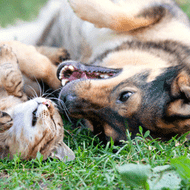The Art of Switching Pet Food: A Comprehensive Guide for Dogs and Cats in the UK
Posted by Ben Watson on 19th Jul 2023
Introduction
As responsible pet owners in the UK, we always strive to provide the best care for our furry companions. When it comes to switching pet food, it's crucial to approach the process with care and consideration. Whether you're transitioning to a new brand or following a veterinarian's recommendation for a different diet, a smooth switch is vital to avoid upsetting your pet's stomach. In this article, we'll explore the best practices for switching your dog's food, including a gradual transition, monitoring adverse food reactions, evaluating stool quality, and choosing the right dog food available in the UK.
Transitioning to a New Dog Food
Switching your dog's food abruptly can lead to digestive issues and reluctance to eat. To ensure a successful transition, follow these guidelines:
1. Transition Period: Plan for a transition period of about 5-7 days. During this time, you'll gradually introduce the new food while reducing the old food.
2. Gradual Incorporation: Start by mixing 25% of the new food with 75% of the old food on the first day. Gradually increase the proportion of the new food and decrease the old food over the course of the transition period.
3. Progression Schedule: Here's a sample progression schedule for transitioning dog foods:
- Day 1: 25% new diet and 75% old diet.
- Day 3: 50% new diet and 50% old diet.
- Day 5: 75% new diet and 25% old diet.
- Day 7: 100% new diet.
4. Monitor Your Dog's Response: Pay close attention to any changes in your dog's appetite, stool quality, and behavior during the transition period. If you notice any concerning signs, such as vomiting, diarrhea, or a lack of interest in food, slow down the transition process and consult your veterinarian if needed.
Adverse Food Reactions in Dogs
Adverse food reactions in dogs can manifest as food allergies, food intolerances, or gastrointestinal diseases. These reactions may lead to gastrointestinal issues like vomiting, diarrhea, and changes in appetite, as well as cutaneous symptoms such as itching, skin inflammation, and hair loss.
If your dog shows signs of an adverse food reaction, it's important to consult with your veterinarian. They may recommend an elimination diet trial, where your dog will be fed a hypoallergenic diet for at least eight weeks. This trial helps identify problematic ingredients and determine if food is the cause of the reaction.
Evaluating Stool Quality
Monitoring your dog's stool can provide valuable insights into their digestive health. While slight variations in color and consistency are normal, significant changes can indicate underlying issues. Using a Fecal Scoring Chart can help assess your dog's stool quality. Ideally, the stool should fall within the normal range, indicating good digestive health.
If your dog consistently has abnormal stool, it's advisable to consult your veterinarian to address any concerns and ensure your pet's digestive health is properly managed.
Choosing the Right Dog Food
Selecting the right dog food in the UK requires careful consideration. With numerous options available, it's essential to make informed choices based on your dog's specific needs. Consider the following factors when choosing dog food:
1. Read the Labels: Pay attention to the ingredient list and nutritional information on the packaging. Look for dog foods that meet the standards set by the European Pet Food Industry Federation (FEDIAF). These standards ensure a complete and balanced diet for your pet.
2. Quality Matters: Choose high-quality dog food brands that prioritize natural, wholesome ingredients and avoid artificial additives and fillers.
3. Consult Your Veterinarian: Your veterinarian is a valuable resource when it comes to choosing the right dog food for your pet. They can provide guidance based on your dog's age, breed, health condition, and specific dietary requirements.
Conclusion
Switching your pet's food requires careful planning and consideration to ensure a smooth transition. By following a gradual transition plan, monitoring for adverse food reactions, evaluating stool quality, and choosing the right dog food available in the UK, you can provide your furry companion with a balanced diet that supports their overall health and well-being. Hyperdrug offers a wide selection of cat food and dog food options that meet high-quality standards. Remember to consult your veterinarian for personalized advice and to address any concerns throughout the process. With proper care and attention, you can make the switch to a new pet food a successful and beneficial experience for your dog or cat.

